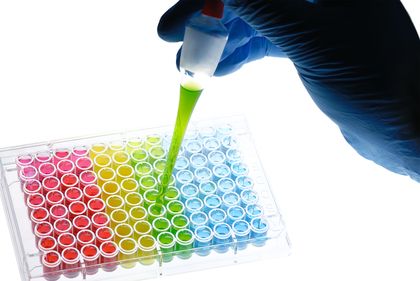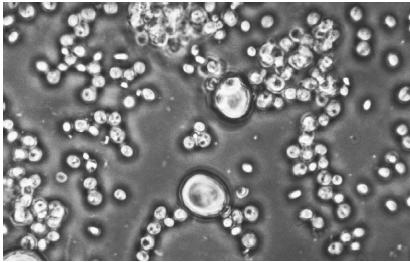Enzymes - Real-life applications

The Body, Food, and Digestion
Enzymes enable the many chemical reactions that are taking place at any second inside the body of a plant or animal. One example of an enzyme is cytochrome, which aids the respiratory system by catalyzing the combination of oxygen with hydrogen within the cells. Other enzymes facilitate the conversion of food to energy and make possible a variety of other necessary biological functions. Enzymes in the human body fulfill one of three basic functions. The largest of all enzyme types, sometimes called metabolic enzymes, assist in a wide range of basic bodily processes, from breathing to thinking. Some such enzymes are devoted to maintaining the immune system, which protects us against disease, and others are involved in controlling the effects of toxins, such as tobacco smoke, converting them to forms that the body can expel more easily.
A second category of enzyme is in the diet and consists of enzymes in raw foods that aid in the process of digesting those foods. They include proteases, which implement the digestion of protein; lipases, which help in digesting lipids or fats; and amylases, which make it possible to digest carbohydrates. Such enzymes set in motion the digestive process even when food is still in the mouth. As these enzymes move with the food into the upper portion of the stomach, they continue to assist with digestion.
The third group of enzymes also is involved in digestion, but these enzymes are already in the body. The digestive glands secrete juices containing enzymes that break down nutrients chemically into smaller molecules that are more easily absorbed by the body. Amylase in the saliva begins the process of breaking down complex carbohydrates into simple sugars. While food is still in the mouth, the stomach begins producing pepsin, which, like protease, helps digest protein.
Later, when food enters the small intestine, the pancreas secretes pancreatic juice—which contains three enzymes that break down carbohydrates, fats, and proteins—into the duodenum, which is part of the small intestine. Enzymes from food wind up among the nutrients circulated to the body through plasma, a watery liquid in which red blood cells are suspended. These enzymes in the blood assist the body in everything from growth to protection against infection.
One digestive enzyme that should be in the body, but is not always present, is lactase. As we noted earlier, lactase works on lactose, the principal carbohydrate in milk, to implement its digestion. If a person lacks this enzyme, consuming dairy products may cause diarrhea, bloating, and cramping. Such a person is said to be "lactose intolerant," and if he or she is to consume dairy products at all, they must be in forms that contain lactase. For this reason, Lactaid milk is sold in the specialty dairy section of major supermarkets, while many health-food stores sell lactaid tablets.
Fermentation
Fermentation, in its broadest sense, is a process involving enzymes in which a compound rich in energy is broken down into simpler substances. It also is sometimes identified as a process in which large organic molecules (those containing hydrogen and carbon) are broken down into simpler molecules as the result of the action of microorganisms working anaerobically, or in the absence of oxygen. The most familiar type of fermentation is the conversion of sugars and starches to alcohol by enzymes in yeast. To distinguish this reaction from other kinds of fermentation, the process is sometimes termed alcoholic or ethanolic fermentation.
At some point in human prehistory, humans discovered that foods spoil, or go bad. Yet at the dawn of history—that is, in ancient Sumer and Egypt—people found that sometimes the "spoilage" (that is, fermentation) of products could have beneficial results. Hence the fermentation of fruit juices, for example, resulted in the formation of primitive forms of wine. Over the centuries that followed, people learned how to make both alcoholic beverages and bread through the controlled use of fermentation.
ALCOHOLIC BEVERAGES.
In fermentation, starch is converted to simple sugars, such as sucrose and glucose, and through a complex sequence of some 12 reactions, these sugars then are converted to ethyl alcohol (the kind of alcohol that can be consumed, as opposed to methyl alcohol and other toxic forms) and carbon dioxide. Numerous enzymes are needed to carry out this sequence of reactions,

The alcoholic beverages that can be produced by fermentation vary widely, depending primarily on two factors: the plant that is fermented and the enzymes used for fermentation. Depending on the materials available to them, various peoples have used grapes, berries, corn, rice, wheat, honey, potatoes, barley, hops, cactus juice, cassava roots, and other plant materials for fermentation to produce wines, beers, and other fermented drinks. The natural product used in making the beverage usually determines the name of the synthetic product. Thus, for instance, wine made with rice—a time-honored tradition in Japan—is known as sake, while a fermented beverage made from barley, hops, or malt sugar has a name very familiar to Americans: beer. Grapes make wine, but "wine" made from honey is known as mead.
OTHER FOODS.
Of course, ethyl alcohol is not the only useful product of fermentation or even of fermentation using yeast; so, too, are baked goods, such as bread. The carbon dioxide generated during fermentation is an important component of such items. When the batter for bread is mixed, a small amount of sugar and yeast is added. The bread then rises, which is more than just a figure of speech: it actually puffs up as a result of the fermentation of the sugar by enzymes in the yeast, which brings about the formation of carbon dioxide gas. The carbon dioxide gives the batter bulkiness and texture that would be lacking without the fermentation process. Another food-related application of fermentation is the production of one processed type of food from a raw, natural variety. The conversion of raw olives to the olives sold in stores, of cucumbers to pickles, and of cabbage to sauerkraut utilizes a particular bacterium that assists in a type of fermentation.
INDUSTRIAL APPLICATIONS.
There is even ongoing research into the creation of edible products from the fermentation of petroleum. While this may seem a bit far-fetched, it is less difficult to comprehend powering cars with an environmentally friendly product of fermentation known as gasohol. Gasohol first started to make headlines in the 1970s, when an oil embargo and resulting increases in gas prices, combined with growing environmental concerns, raised the need for a type of fuel that would use less petroleum. A mixture of about 90% gasoline and 10% alcohol, gasohol burns more cleanly that gasoline alone and provides a promising method for using renewable resources (plant material) to extend the availability of a nonrenewable resource (petroleum). Furthermore, the alcohol needed for this product can be obtained from the fermentation of agricultural and municipal wastes.
The applications of fermentation span a wide spectrum, from medicines that go into people's bodies to the cleaning of waters containing human waste. Some antibiotics and other drugs are prepared by fermentation: for example, cortisone, used in treating arthritis, can be made by fermenting a plant steroid known as diosgenin. In the treatment of wastewater, anaerobic, or non-oxygen-dependent, bacteria are used to ferment organic material. Thus, solid wastes are converted to carbon dioxide, water, and mineral salts.
WHERE TO LEARN MORE
Asimov, Isaac. The Chemicals of Life: Enzymes, Vitamins, Hormones. New York: Abelard-Schulman, 1954.
"Enzymes: Classification, Structure, Mechanism." Washington State University Department of Chemistry (Web site). <http://www.chem.wsu.edu/Chem102/102-EnzStrClassMech.html> .
"Enzymes." HordeNet: Hardy Research Group, Department of Chemistry, The University of Akron (Web site). <http://ull.chemistry.uakron.edu/genobc/Chapter_20/> .
Fruton, Joseph S. A Skeptical Biochemist. Cambridge, MA: Harvard University Press, 1992.
"Introduction to Enzymes." Worthington Biochemical Corporation (Web site). <http://www.worthingtonbiochem.com/introBiochem/introEnzymes.html> .
Kornberg, Arthur. For the Love of Enzymes: The Odyssey of a Biochemist. Cambridge, MA: Harvard University Press, 1989.
"Milk Makes Me Sick: Exploration of the Basis of Lactose Intolerance." Exploratorium: The Museum of Science, Art, and Human Perception (Web site). <http://www.exploratorium.edu/snacks/milk_makes-me_sick/> .
Comment about this article, ask questions, or add new information about this topic: